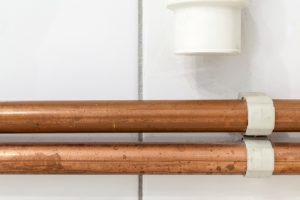 There is a long history of different materials used for pipes in homes. Today, the most common metal used for indoor plumbing is copper. Copper started to take over for other metals in the 1970s, and by the 1990s had replaced such older materials as clay, cast iron, lead, and galvanized steel.
There is a long history of different materials used for pipes in homes. Today, the most common metal used for indoor plumbing is copper. Copper started to take over for other metals in the 1970s, and by the 1990s had replaced such older materials as clay, cast iron, lead, and galvanized steel.
Why did copper become the pipe metal champion? It’s a combination of what’s wrong with those older pipes and what’s so right about copper.
The benefits of copper
Ask any professional plumber in Lake Mary, FL who does repiping work, and they can tell you about how easy copper is to work with. It’s a lightweight metal and cuts easily. For a homeowner, it has a number of other big advantages:
- It costs less than other metals.
- It’s highly durable and has enough flexibility that it won’t easily snap when pressure is placed on it.
- It deals well with temperature changes.
- It’s corrosion-resistant. There are a few specific types of corrosion that can affect it, such as a corrosion caused by formaldehyde (formicary corrosion), but in general, a copper pipe will outlast other materials.
- It won’t place toxins into the water from corrosion or chemical treatments.
The problems with the older metals
To give you an even better sense of why copper superseded other piping materials, we’ll explain why these metals went out of use.
- Lead: You’ve heard about the dangers of lead in drinking water and the harm it can cause to developing children. Lead is not used in plumbing at all today.
- Cast iron: Common in the first half of the 20th century, cast iron pipes are highly prone to corrosion and will eventually crumble away.
- Galvanized steel: For many decades, it looked as if galvanized steel was going to be the main pipe material for ever and ever. Galvanized steel is covered in a zinc solution to resist corrosion. Unfortunately, this same zinc coating eventually washes off the steel and into the water supply. Corrosion catches up with the metal, leading to toxins getting into the water. And compared to copper, galvanized steel is simply harder to work with.
Polybutylene
We want to note a type of plastic that copper overtook as well. During the 1970s and all the way into the early ‘90s, a type of plastic called polybutylene became common for plumbing systems. However, polybutylene has proved itself prone to breakage and is no longer used. If your home was built in the 1970s or ‘80s, we recommend having any polybutylene pipes replaced—before they force you to replace them.
Repiping with copper
If you have a home that was built before 1970 and it has never had any repiping done, it almost certainly needs to have older metal (galvanized steel most likely) removed and replaced with copper—as well as plastic pipes. You only have to call our experienced plumbers to assess your plumbing system to find out how much repiping the house needs. We can take care of the work fast and right.
Replace those older pipes with the best in modern materials with the Modern Way contractor: Modern Plumbing Industries, Inc. Serving Central Florida since 1975.
